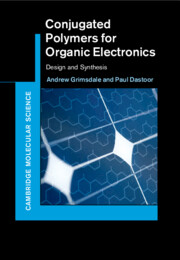Book contents
- Conjugated Polymers for Organic Electronics
- Cambridge Molecular Science
- Conjugated Polymers for Organic Electronics
- Copyright page
- Contents
- Preface
- Abbreviations
- 1 Introduction
- 2 Polyacetylenes
- 3 Poly(arylene vinylene)s
- 4 Poly(arylene ethynylene)s
- 5 Poly(phenylene)s
- 6 Polyfluorenes and Related Polymers
- 7 Polythiophenes
- 8 Other Arylene-Based Polymers
- 9 Hyperbranched Polymers, Star Polymers and Dendrimers
- 10 Polymers with Molecular-like Chromophores
- 11 Polymers for Phosphorescent LEDs
- 12 Polymers for White-Emitting PLEDs
- 13 Polymers for Other Luminescent Devices
- 14 Conclusion and Outlook
- References
- Index
5 - Poly(phenylene)s
Published online by Cambridge University Press: 28 March 2024
- Conjugated Polymers for Organic Electronics
- Cambridge Molecular Science
- Conjugated Polymers for Organic Electronics
- Copyright page
- Contents
- Preface
- Abbreviations
- 1 Introduction
- 2 Polyacetylenes
- 3 Poly(arylene vinylene)s
- 4 Poly(arylene ethynylene)s
- 5 Poly(phenylene)s
- 6 Polyfluorenes and Related Polymers
- 7 Polythiophenes
- 8 Other Arylene-Based Polymers
- 9 Hyperbranched Polymers, Star Polymers and Dendrimers
- 10 Polymers with Molecular-like Chromophores
- 11 Polymers for Phosphorescent LEDs
- 12 Polymers for White-Emitting PLEDs
- 13 Polymers for Other Luminescent Devices
- 14 Conclusion and Outlook
- References
- Index
Summary
Methods for making films of insoluble poly(para-phenylene) (PPP) are described and its potential as a blue-emitting polymer discussed. Efficient methods for making soluble PPP derivatives have been developed but these polymers suffer from undesirable changes in their emission due to twisting of the polymer backbones caused by steric interactions between the solubilising side-chains or by the formation of emissive aggregates in the solid state. To overcome this, ladder-type PPPs (LPPPs) made from precursor polymers have been made and their structure–property relationships and potential utility in devices are discussed. Stable blue emission from LPPPs has proven to be difficult to obtain due to the formation of emissive defects, while their wide bandgaps and unsuitable frontier orbital energies have made them of limited use in other devices.
Keywords
- Type
- Chapter
- Information
- Conjugated Polymers for Organic ElectronicsDesign and Synthesis, pp. 61 - 73Publisher: Cambridge University PressPrint publication year: 2024

